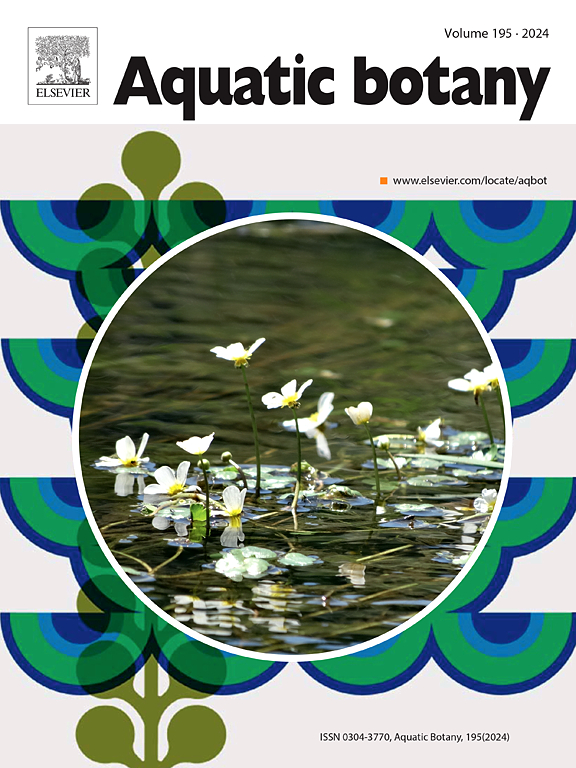美国三种水螅生物型的生长模式
IF 2.6
4区 生物学
Q2 MARINE & FRESHWATER BIOLOGY
引用次数: 0
摘要
水螅[Hydrilla verticillata (l.f. Royle)]是一种入侵的水下植物,于20世纪50年代在美国首次记录。直到最近,在美国只记录了两种不同的水螅菌株,以下称为生物型,它们属于同一进化支,并被描述为“雌雄同株”或“雌雄异株”。2016年,在康涅狄格州的康涅狄格河下游发现了第三种遗传上独特的生物型(“进化枝C”)。试验在北卡罗来纳州的两个地理位置独特的地方进行,以比较气候条件下水螅生物型的生长和繁殖。尽管在研究期间雌雄异株水螅的生物量峰值没有出现,但在地上生物量峰值、相对生长率或这些指标的出现情况上,三种水螅生物型均存在名义差异。雌雄同株水螅的地下生物量峰值低于雌雄异株和C支系水螅,尽管其地下生物量丰富。雌雄同株水螅在种植后180天(朱利安日304)的地上生物量是C枝水螅的1.8倍。在304朱利安日,C枝水螅每株产生74个腋生旋转体,相当于比雌雄同株水螅增加2.3倍,比雌雄异株水螅增加61.5倍。相反,雌雄同株水螅和雌雄异株水螅的地下轮产量分别比C支系高4.7倍和7.1倍。这些研究表明,在美国,C枝水鸡在物候上与其他两种生物型有许多相似之处,但其惊人的腋窝turion产量对管理后的传播和持久性具有潜在的影响。本文章由计算机程序翻译,如有差异,请以英文原文为准。
Growth patterns of three Hydrilla verticillata biotypes in the United States
Hydrilla [Hydrilla verticillata (L.f. Royle)] is an invasive submersed plant first documented in the United States (US) in the 1950s. Until recently, only two distinct strains of hydrilla, hereafter referred to as biotypes, were recorded in the US with both belonging to the same clade and characterized as either ‘monoecious’ or ‘dioecious’. In 2016, a third genetically distinct biotype (‘clade C’) was identified in the lower Connecticut River, Connecticut. Trials were conducted at two geographically unique locations within North Carolina to compare growth and reproduction of hydrilla biotypes by climatic conditions. Nominal differences were observed in peak aboveground biomass, relative growth rate, or occurrence of these metrics among the three hydrilla biotypes, although the predicted peak biomass for dioecious hydrilla did not occur during the study period. Monoecious hydrilla exhibited lower peak belowground biomass than dioecious and clade C hydrilla despite its abundant subterranean turion production. Monoecious hydrilla exhibited 1.8X greater aboveground biomass 180 days after planting (Julian day 304) than clade C hydrilla. Clade C hydrilla produced 74 axillary turions per plant on Julian day 304, which equates to a 2.3X increase over monoecious hydrilla and 61.5X increase over dioecious hydrilla. Conversely, subterranean turion production was 4.7 and 7.1X higher in monoecious hydrilla and dioecious hydrilla than clade C hydrilla, respectively. These studies suggest the clade C hydrilla displays many phenological similarities to the other two biotypes in the US, but its prodigious axillary turion production poses concerning implications for potential to spread and persistence following management.
求助全文
通过发布文献求助,成功后即可免费获取论文全文。
去求助
来源期刊

Aquatic Botany
生物-海洋与淡水生物学
CiteScore
3.80
自引率
5.60%
发文量
70
审稿时长
6 months
期刊介绍:
Aquatic Botany offers a platform for papers relevant to a broad international readership on fundamental and applied aspects of marine and freshwater macroscopic plants in a context of ecology or environmental biology. This includes molecular, biochemical and physiological aspects of macroscopic aquatic plants as well as the classification, structure, function, dynamics and ecological interactions in plant-dominated aquatic communities and ecosystems. It is an outlet for papers dealing with research on the consequences of disturbance and stressors (e.g. environmental fluctuations and climate change, pollution, grazing and pathogens), use and management of aquatic plants (plant production and decomposition, commercial harvest, plant control) and the conservation of aquatic plant communities (breeding, transplantation and restoration). Specialized publications on certain rare taxa or papers on aquatic macroscopic plants from under-represented regions in the world can also find their place, subject to editor evaluation. Studies on fungi or microalgae will remain outside the scope of Aquatic Botany.
 求助内容:
求助内容: 应助结果提醒方式:
应助结果提醒方式:


